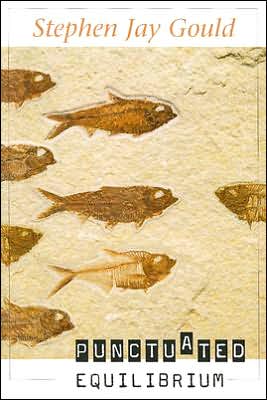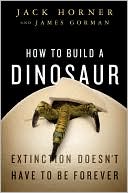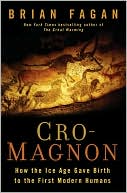Punctuated Equilibrium
In 1972 Stephen Jay Gould took the scientific world by storm with his paper on punctuated equilibrium, written with Niles Eldredge. Challenging a core assumption of Darwin's theory of evolution, it launched the career of one of the most influential evolutionary biologists of our time—perhaps the best known since Darwin.\ Now, thirty-five years later, and five years after his untimely death, Punctuated Equilibrium (originally published as the central chapter of Gould's masterwork, The...
Search in google:
In 1972 Stephen Jay Gould took the scientific world by storm with his paper on punctuated equilibrium, written with Niles Eldredge. Challenging a core assumption of Darwin's theory of evolution, it launched the career of one of the most influential evolutionary biologists of our time—perhaps the best known since Darwin. Now, thirty-five years later, and five years after his untimely death, Punctuated Equilibrium (originally published as the central chapter of Gould's masterwork, The Structure of Evolutionary Theory) offers his only book-length testament on an idea he fiercely promoted, repeatedly refined, and tirelessly defended. Punctuated equilibrium holds that the great majority of species originate in geological moments (punctuations) and persist in stasis. The idea was hotly debated because it forced biologists to rethink entrenched ideas about evolutionary patterns and processes. But as Gould shows here in his typically exhaustive coverage, the idea has become the foundation of a new view of hierarchical selection and macroevolution. What emerges strikingly from this book is that punctuated equilibrium represents a much broader paradigm about the nature of change—a worldview that may be judged as a distinctive and important movement within recent intellectual history. Indeed we may now be living within a punctuation, and our awareness of what this means may be the enduring legacy of one of America's best-loved scientists. Atlantic Monthly The untimely death of Stephen Jay Gould deprived the world of a superb writer and popularizer of important events and processes in biology. But Gould was also a genuinely original thinker, capable of challenging even basic tenets of Darwinian notions of evolution. This latest posthumous volume, which was the central chapter of his magnum opus, The Structure of Evolutionary Theory, argues that Darwin's theory of a steady continuum of evolutionary progress was incorrect. Rather, Gould posits, most species have originated during punctuated geologic moments, and persisted through the periods of stasis that followed. Just as, more than a century ago, quantum theory proved that in physics, things sometimes moved forward in spurts, Gould intuited that this was also true for aspects of evolutionary biology.
Introduction1. What Every Paleontologist KnowsAn Introductory ExampleTestimonials to Common KnowledgeDarwinian Solutions and ParadoxesThe Paradox of Insulation from DisproofThe Paradox of Stymied Practice2. The Primary Claims of Punctuated EquilibriumData and DefinitionsMicroevolutionary LinksMacroevolutionary ImplicationsTempo and the Significance of StasisMode and the Speciational Foundation of Macroevolution3. The Scientific Debate on Punctuated Equilibrium: Critiques and ResponsesCritiques Based on the Definability of Paleontological SpeciesEmpirical AffirmationReasons for a Potential Systematic Underestimation of Biospecies by PaleospeciesReasons for a Potential Systematic Overestimation of Biospecies by PaleospeciesReasons Why an Observed Punctuational Pattern Might Not Represent SpeciationCritiques Based on Denying Events of Speciation as the Primary Locus of ChangeCritiques Based on Supposed Failures of Empirical Results to Affirm Predictions of Punctuated EquilibriumClaims for Empirical Refutation by CasesPhenotypesGenotypesEmpirical Tests of Conformity with Models4. Sources of Data for Testing Punctuated EquilibriumPreambleThe Equilibrium in Punctuated Equilibrium: Quantitatively Documented Patterns of Stasis in Unbranched Segments of LineagesThe Punctuations of Punctuated Equilibrium: Tempo and Mode in the Origin of PaleospeciesThe Inference of Cladogenesis by the Criterion of Ancestral SurvivalThe "Dissection" of Punctuations to Infer Both Existence and ModalityTimeGeographyMorphometric ModeProper and Adequate Tests of Relative Frequencies: The Strong Empirical Validation of Punctuated EquilibriumThe Indispensability of Data on Relative FrequenciesRelative Frequencies for Higher Taxa in Entire BiotasRelative Frequencies for Entire CladesCausal Clues from Differential Patterns of Relative Frequencies5. The Broader Implications of Punctuated Equilibrium for Evolutionary Theory and General Notions of ChangeWhat Changes May Punctuated Equilibrium Instigate in Our Views about Evolutionary Mechanisms and the History of Life?The Explanation and Broader Meaning of StasisFrequencyGeneralityCausalityPunctuation, the Origin of New Macroevolutionary Individuals, and Resulting Implications for Evolutionary TheoryTrendsThe Speciational Reformulation of MacroevolutionEcological and Higher-Level ExtensionsPunctuation All the Way Up and Down? The Generalization and Broader Utility of Punctuated Equilibrium (in More Than a Metaphorical Sense) at Other Levels of Evolution, and for Other Disciplines In and Outside the Natural SciencesGeneral Models for Punctuated EquilibriumPunctuational Change at Other Levels and Scales of EvolutionA Preliminary Note on Homology and Analogy in the Conceptual RealmPunctuation Below the Species LevelPunctuation Above the Species LevelPunctuational Models in Other Disciplines: Towards a General Theory of ChangePrinciples for a Choice of ExamplesExamples from the History of Human Artifacts and CulturesExamples from Human Institutions and Theories about the Natural WorldTwo Concluding Examples, a General Statement, and a CodaAppendix: A Largely Sociological (and Fully Partisan) History of the Impact and Critique of Punctuated EquilibriumThe Entrance of Punctuated Equilibrium into Common Language and General CultureAn Episodic History of Punctuated EquilibriumEarly Stages and Future ContextsCreationist Misappropriation of Punctuated EquilibriumPunctuated Equilibrium in Journalism and TextbooksThe Personal Aspect of Professional ReactionThe Case Ad Hominem against Punctuated EquilibriumAn Interlude on Sources of ErrorThe Wages of JealousyThe Descent to NastinessThe Most Unkindest Cut of AllThe Wisdom of Agassiz's and von Baer's Threefold History of Scientific IdeasA Coda on the Kindness and Generosity of Most ColleaguesNotesBibliographyIllustration CreditsIndex
\ New ScientistIn a brilliant move, Belknap Press has posthumously extracted a single chapter—number nine—from The Structure of Evolutionary Theory and published it as a stand-alone book, Punctuated Equilibrium. It's a testimony to the density of the work that a single chapter is sufficient to make a complete and thorough book on its own. The publisher has simply cut away the first 745 pages and the last 318 of the original. What's left is a text that is sharply focused on the theory for which Gould and his colleague Niles Eldredge are best known. It works beautifully...Gould documents the evidence for his controversial theory and its implications in impressive detail. The book is rich in data and dense in theory, representing a powerful summary of the arguments...Gould, in his typically immodest way, suggested that the theory of punctuated equilibrium could tell us about much more than the rate of evolution, and that it pointed to a whole new hierarchy of evolutionary phenomena. He proposed that the discipline of evolutionary biology should be expanded to accommodate new ideas that he, in part, had established. Inevitably that raised hackles. Yet critics and proponents must read his ideas. This sharp, detailed extract from his last great work offers an essential summary.\ — P. Z. Myers\ \ \ \ \ \ Atlantic MonthlyThe untimely death of Stephen Jay Gould deprived the world of a superb writer and popularizer of important events and processes in biology. But Gould was also a genuinely original thinker, capable of challenging even basic tenets of Darwinian notions of evolution. This latest posthumous volume, which was the central chapter of his magnum opus, The Structure of Evolutionary Theory, argues that Darwin's theory of a steady continuum of evolutionary progress was incorrect. Rather, Gould posits, most species have originated during punctuated geologic moments, and persisted through the periods of stasis that followed. Just as, more than a century ago, quantum theory proved that in physics, things sometimes moved forward in spurts, Gould intuited that this was also true for aspects of evolutionary biology.\ \ \ \ Atlantic MonthlyThe untimely death of Stephen Jay Gould deprived the world of a superb writer and popularizer of important events and processes in biology. But Gould was also a genuinely original thinker, capable of challenging even basic tenets of Darwinian notions of evolution. This latest posthumous volume, which was the central chapter of his magnum opus, The Structure of Evolutionary Theory, argues that Darwin's theory of a steady continuum of evolutionary progress was incorrect. Rather, Gould posits, most species have originated during punctuated geologic moments, and persisted through the periods of stasis that followed. Just as, more than a century ago, quantum theory proved that in physics, things sometimes moved forward in spurts, Gould intuited that this was also true for aspects of evolutionary biology.\ \ \ \ \ New ScientistIn a brilliant move, Belknap Press has posthumously extracted a single chapter--number nine--from The Structure of Evolutionary Theory and published it as a stand-alone book, Punctuated Equilibrium. It's a testimony to the density of the work that a single chapter is sufficient to make a complete and thorough book on its own. The publisher has simply cut away the first 745 pages and the last 318 of the original. What's left is a text that is sharply focused on the theory for which Gould and his colleague Niles Eldredge are best known. It works beautifully...Gould documents the evidence for his controversial theory and its implications in impressive detail. The book is rich in data and dense in theory, representing a powerful summary of the arguments...Gould, in his typically immodest way, suggested that the theory of punctuated equilibrium could tell us about much more than the rate of evolution, and that it pointed to a whole new hierarchy of evolutionary phenomena. He proposed that the discipline of evolutionary biology should be expanded to accommodate new ideas that he, in part, had established. Inevitably that raised hackles. Yet critics and proponents must read his ideas. This sharp, detailed extract from his last great work offers an essential summary.\ — P. Z. Myers\ \








